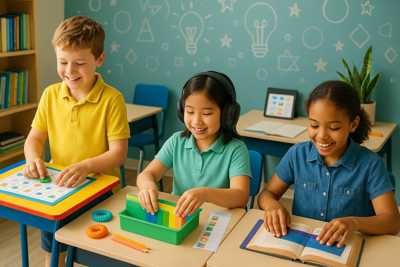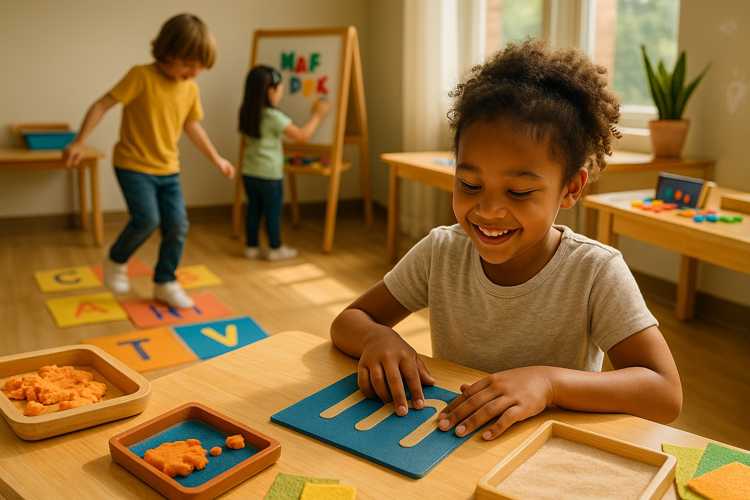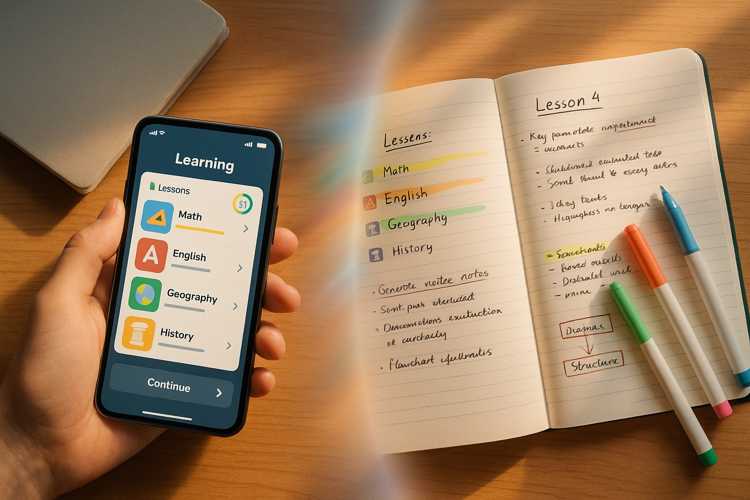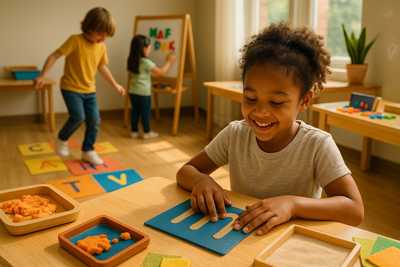How Neurodivergent Children Learn Differently—and Why That's Actually Kind of Brilliant

Image made with AI (DALL-E)
Discover how neurodivergent children learn differently with evidence-based strategies. Learn about ADHD, autism, and dyslexia learning differences plus teaching approaches that unlock their superpowers.
Picture this: A third-grader bounces in her seat during math. Teachers call her "disruptive." Her parents stress-eat. Everyone agrees something needs fixing.
But what if I told you that same kid might be someone who solves problems no one else sees coming, who notices patterns like a human algorithm, who thinks in ways that'll probably make her wildly successful someday?
Here's the plot twist nobody tells us: the classroom isn't designed for how neurodivergent children learn differently. It's not broken—the system is.
For decades, education treated neurodivergence like a manufacturing defect. You know, like the toaster that makes toast too dark. But research keeps whispering a different story: when we stop trying to rewire these kids and instead understand how they're already wired, something magical happens. They don't just survive school—they actually learn.
Their unique cognitive operating system? That's not a bug. That's a feature.
Understanding Neurodivergence: More Common Than You Think
Neurodivergence is basically the brain's version of being left-handed in a right-handed world. It refers to natural variations in how human brains process information. Not disorders. Not deficits. Just… different.
Think of it like this: neurotypical brains are like factory-standard software. Neurodivergent brains are customized builds with different operating parameters.
The usual suspects include:
- ADHD: The brain's attention dial is stuck between "laser focus" and "scattered everywhere." There's no medium. (Spoiler: this isn't laziness or lack of intelligence.)
- Autism Spectrum Disorder: Different wiring in social communication, sensory processing, and how they experience the world
- Dyslexia: The brain processes written language differently—not because of intelligence, but because of how it organizes symbols
- Dyscalculia: Numbers are the enemy, but logic? Sharp as a tack
- Dysgraphia: Writing by hand feels like typing with oven mitts on
- Dyspraxia: Coordination isn't their thing, but problem-solving often is
Here's what'll blow your mind: roughly 1 in 5 kids is neurodivergent. That's not rare. That's just how a significant chunk of human brains operate.
And here's the crucial bit: ADHD, autism, and dyslexia learning differences don't mean being unintelligent. A neurodivergent kid can be gifted, average, or struggle in specific areas. What matters is how their brain organizes information, not their raw processing power.
The Neurodivergent Brain: Understanding Information Processing Differences
Let's get nerdy about neurobiology for a second, because understanding why traditional teaching fails these kids changes everything.
The Attention Paradox
With ADHD especially, the brain doesn't have an attention problem—it has an attention regulation problem. Imagine a browser with 47 tabs open. That's neurodivergent attention. Neurodivergent brain information processing works differently when it comes to filtering stimulus.
Here's the kicker: give that same kid a topic they genuinely care about, and suddenly they experience hyperfocus in ADHD children—a learning advantage that becomes a superpower. Three hours evaporate like thirty minutes. This isn't contradiction; it's evidence that their brain can focus intensely. It just needs the right fuel (genuine interest) rather than obligatory boring stuff.
Sensory Overload and Processing Challenges
Many neurodivergent kids experience the world like someone turned all the dials to 11. Fluorescent lights? Migraine-inducing. Background noise? Maddening. Certain textures? Absolutely not. Sensory processing challenges in the classroom environment can derail an entire day of learning.
Others go the opposite direction—they're hyposensitive and need more sensory input to feel regulated. Neither is a character flaw. Both are neurological reality. Understanding these differences is essential for creating supportive learning spaces.
Executive Function: The Brain's Project Manager
Executive function difficulties in neurodivergent students stem from how their brains handle planning, organizing, and time management. This department might have different staffing, unusual work hours, or a completely different filing system. Multi-step instructions become overwhelming. Long-term projects feel impossible. But that's a scaffolding problem, not a capability problem.
How Neurodivergent Kids Actually Learn Best
Every neurodivergent child is their own beautiful snowflake, but certain learning superpowers keep showing up, revealing the true strengths of neurodivergent learners in school:
Hyperfocus: The Superpower Everyone Overlooks
Your ADHD kid abandoned their math worksheet but built an architectural marvel out of Legos for four hours straight? That's not distraction. That's hyperfocus in ADHD children—and it's a strength. These kids can dive so deep into their interests that they develop genuine expertise. Channel that toward learning? Unstoppable.
Visual Spatial Thinking and Pattern Recognition
Neurodivergent brains often engage in visual spatial thinking that helps them see patterns, relationships, and connections that linear thinkers miss entirely. The pattern recognition abilities of neurodivergent thinkers are natural architects, systems thinkers, and designers. While they might struggle with step-by-step instructions, give them a visual blueprint and they're gold.
Creative Problem-Solving Excellence
Traditional approach: Step 1, Step 2, Step 3, Answer.
Neurodivergent approach: [Somehow arrives at a completely different solution that's actually better]
Creative problem solving in neurodivergent children doesn't follow the manual because their brains are already writing a better one. In a world obsessed with innovation, this is increasingly valuable.
Hands-On Learning That Engages the Brain
"Just listen" doesn't work. "Just focus" doesn't work. But hands-on learning strategies for neurodivergent kids create breakthroughs. "Build something," "move around," "touch it," "experience it"? Suddenly they're locked in and learning.
Attention to Detail That's Invaluable
While some neurodivergent folks struggle with big-picture stuff, others notice everything—every typo, every inconsistency, every pixel out of place. Quality control? Pattern recognition? These kids are walking QA departments.
Where Traditional Classrooms Create Barriers
Let me be direct: conventional classrooms create artificial barriers for neurodivergent learners:
The "One-Size-Fits-All" Pace Doesn't Work
We force all kids through the same content at the same speed like they're assembly-line widgets. A neurodivergent kid who needs flexible pacing and differentiated instruction? Gets labeled "behind" or "slow," even though their brain simply processes differently.
Standardized Testing Measures the Wrong Thing
Multiple-choice, timed tests represent standardized testing disadvantages for neurodivergent students—they don't actually measure what these kids know. They measure how well you perform under that specific testing format. A visual thinker drowns in word problems. A kid with processing delays runs out of time despite knowing the material. The test tells us nothing except "this format doesn't match this brain."
Forced Stillness Backfires
Neurodivergent kids often need movement to focus. Movement breaks for classroom ADHD students aren't distractions—they're necessary. Forcing stillness creates dysregulation, anxiety, and ironically worse focus. It's like asking someone to concentrate while standing on one leg in ice water.
Schools Focus on Deficits, Not Strengths
The system is laser-focused on what's "wrong." These kids spend their days hearing what they suck at instead of discovering what they're phenomenal at. That's not education; that's psychological damage disguised as pedagogy.
Teaching Strategies That Actually Work
When we teach to how neurodivergent brains work instead of against them, magic happens:
Multi-Sensory Learning Transforms Education
Skip the lecture. Multi-sensory learning for ADHD children and other neurodivergent learners involves manipulatives you can touch, visual representations, real-world applications. A kid learns fractions better by actually cutting pizzas into pieces than by staring at worksheets.
Chunk Information Into Manageable Pieces
Complex information becomes manageable when chunked. And forget artificial timelines. Flexible pacing differentiated instruction for neurodivergent learners means if a kid needs three weeks to go deep on a topic, let them. If another masters it in three days? Great. Different != wrong.
Movement Enables Focus
Fidget tools, standing desks, movement breaks, active learning—these aren't distractions, they're the fuel that enables focus. A kid who fidgets while learning isn't being disruptive; they're regulating their nervous system so their brain can actually absorb information.
Visual Supports Reduce Cognitive Load
Written instructions, color-coded systems, graphic organizers, visual schedules—visual supports and assistive technology for neurodivergent learners remove unnecessary cognitive overhead so working memory can focus on actual learning instead of information management.
Interest-Based Learning Drives Engagement
A kid obsessed with space? Interest-based learning means teaching them reading, writing, and research through astronomy. They'll develop those skills faster than any generic curriculum because they actually care. Novel concept, right?
Reduce Cognitive Load
Simplify. Minimize distractions. Give clear, concise instructions. Cognitive load reduction in teaching neurodivergent learners helps their brain focus on actual learning instead of drowning in logistics.
The Hidden Superpowers of Neurodivergent Minds
When properly supported, these kids develop abilities that neurotypical peers often never touch, showcasing the real strengths of neurodivergent learners:
Attention to Detail That's Literally Valuable
They notice errors, inconsistencies, and anomalies. In quality assurance, data analysis, specialized research, and precision work? This becomes indispensable.
Innovation Born from Different Thinking
They approach problems sideways. The solution nobody else saw? That's them. In a world obsessed with disruption and innovation, different thinking is currency.
Passion and Dedication That Won't Quit
Once engaged, they go deep. This intense focus and commitment creates genuine expertise and excellence.
Resilience Built from Navigating an Unsuitable World
These kids are basically playing on hard mode. The problem-solving skills, psychological toughness, and adaptability they develop? That serves them their entire lives.
Advocacy: Getting Your Child the Support They Deserve
Neurodivergent kids need champions who understand the system. Here's how parents can advocate for neurodivergent accommodations in school:
Know Your Legal Arsenal
In the US, there's 504 Plans and IEPs (Individualized Education Programs)—legal documents that require accommodations. Know what your kid qualifies for. This isn't optional; it's law.
Talk Smart with Schools
Frame conversations around learning needs, not limitations. Bring research. Show specific teaching strategies for neurodivergent kids that work. Collaborate, don't combat.
Request Smart Accommodations
Extended time on tests, movement breaks, modified assignments that assess the same skills differently—these provide access, not unfair advantage. There's a difference.
Create a Home Environment That Honors How They Learn
Sensory tools, hyperfocus time on interests, celebrating their unique strengths—these small things compound into big confidence.
The Bottom Line: Your Kid Isn't Broken
That neurodivergent child in your life? The one everyone says needs "fixing"?
They're not broken. They're differently configured.
And when we stop trying to force them into a neurotypical mold and instead build systems that actually work with their brain, something remarkable happens. They stop struggling to fit and start thriving by being authentically themselves.
Every neurodivergent kid deserves an education where their brain isn't just tolerated—it's understood, celebrated, and developed into the incredible strength it actually is.
That's not just better education. That's justice.
Links marked with an asterisk (*) are affiliate links to external offers. If you click on such a link and make a purchase through it, we receive a commission from the provider. The price does not change for you.
Related Articles

From Frustration to Fun - Turning Writing Practice Into Play
Discover game-based writing exercises that transform reluctant writers into eage...
9 min read
Building Reading Confidence Through Multisensory Activities That Actually Work
Discover research-backed hands-on reading techniques using touch, sound, and mov...
10 min read
Creating a Calm Learning Space at Home - A Parent's Guide to Better Focus
Discover how lighting, sound, temperature, and texture impact your child's focus...
13 min read
Bridging Apps and Offline Learning - Making Tech Work for You
Discover how combining educational apps with physical workbooks boosts retention...
8 min read
